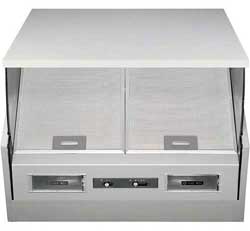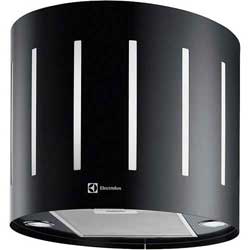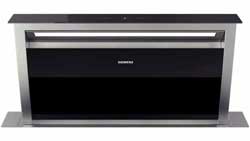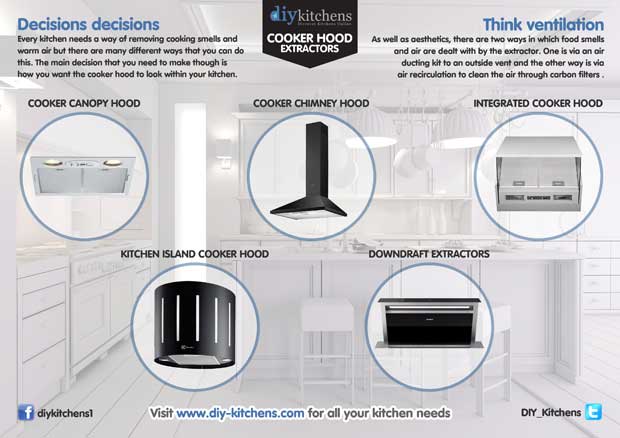When designing your kitchen, it’s important to think about how the hot air and smells from the hob are going to be extracted. When doing this, there are a few cooker hood options depending on your preferences like where the hob will be installed and ultimately, how much of a budget you have to spend on this appliance. Another consideration to make is how the air will be ventilated and cleaned.
Quick links
- Air extraction ventilation explained
- Air recirculation ventilation explained
- Chimney hoods
- Canopy hoods
- Integrated hoods
- Kitchen island hoods
- Downdraft extractors
The next 2 sections will cover air ventilation.
Air extraction ventilation explained
The air extraction system (ducting) uses aluminium filters to absorb all the grease, which can be washed in warm soapy water when cleaning is required. If you are just using aluminium filters then you will need a ducting kit for the cooker canopy to send the air outside.
Ducting kits are usually bought separately and don’t usually come with the cooker hoods, unless stated.
Air recirculation ventilation explained
The air recirculation method also uses the aluminium filters to absorb the grease, but the air is then passed through a carbon/charcoal filter to clean it and then passes the clean air back into the kitchen.
The sections below show some of the most common types of cooker hoods and extractors available for your kitchen, which are listed in order of cost.
 Chimney hoods
Chimney hoods
Chimney hoods are very popular in many kitchens. The hood stands proud above the hob and features a tall chimney that usually reaches to the ceiling to allow extraction of cooking smells and warm air. Recirculation versions of these units are available but if you have the chimney version, then you might as well use it for the purpose in which it was made:-)
On our website you would expect to pay between £65 and £700 for a chimney hood.
 Canopy cooker hoods
Canopy cooker hoods
A cooker canopy hood is a very simple and convenient way of removing smells and odours from your kitchen. The canopy fits neatly on the underside of a kitchen unit and is virtually unnoticeable, apart from the controls on the underside of the unit. These types of cooker hoods can use both the recirculation and extraction systems to deal with odours and smells, but this depends on the model that you buy.
On our website you would expect to pay between £70 and £170 for a canopy hood.
 Integrated hoods
Integrated hoods
Integrated cooker hoods, much like canopy hoods fit seamlessly into your kitchen. But, these types of cooker hoods require their own space in your kitchen between 2 existing wall units. Once fitted, a door is then attached to the front of the integrated hood unit so that it blends in with the rest of the kitchen. The door then allows you to pull open the unit, which allows for escaping air and odours to be captured and dealt with.
These types of cooker hoods can use an extraction system or a recirculation system, depending on your own personal preferences.
On our website you would expect to pay between £80 and £800 for a integrated hood.
 Kitchen island hoods
Kitchen island hoods
Kitchen island hoods are big and can come with a hefty price tag, but if you have the space for a kitchen island and you are planning on doing all the cooking on it then you are going to need an island hood.
Although these units are quite big, they can look pretty attractive with some of them featuring built in lights to give your kitchen some ambience once the cooking is complete.
Some of these kitchen island hob extractors also come with external ventilation and air recirculation models. Air recirculation is a method that is used if there is no way to push the air outside through a chimney system from the cooker hood. The air is cleaned through a charcoal filter and fresh cleaner air is dispensed back into the kitchen.
On our website you would expect to pay between £360 and £1000 for a kitchen island hood.
 Downdraft extractors
Downdraft extractors
If there is no space in your home for a traditional cooker hood or you just don’t like the sight of them, then there is a solution, albeit an expensive one. It’s called the downdraft extractor.
These extractors are slotted into your kitchen worktop and will pop out when needed at the touch of a button. See the example picture above to see what they look like and how they function. This is by far the coolest type of hob extractor out there and quite possibly the most expensive but hey, cool gadgets don’t come cheap!
On our website you would expect to pay around £1000+ for a downdraft extractor.
Follow DIY Kitchens’s board Cooker Canopy Hoods on Pinterest.
You can see all the cooker hoods shown in the image below.
 You can download a copy of the image above as a PDF here.
You can download a copy of the image above as a PDF here.
Download our mobile app
Looking for some kitchen inspiration? Take a look at some of our real customer kitchens, video reviews as well as advice in our mobile app. We’ll also keep you up to date with any new ranges and offers that we have available.
Up to 50% off competitor kitchen prices
At DIY Kitchens, not only do you get a quality rigid built kitchen but you also get it at a fabulous price too! Price your kitchen up on our site and you could see savings of up to 50% off other kitchen quotes that you’ve had.
Take a look at our kitchen price comparison page here.
Real customer kitchens
Get some inspiration for designing your own new kitchen with over 3,000 pictures of our customers’ kitchens that they ordered from us.
Hi. If I order both a cabinet and a canopy extractor on your site, will you fit/install the extractor to the cabinet or do I need to do it myself?
Thank You!
Hi Olesia, we only supply the units. The extractor will need fitting onsite by you or your kitchen fitter.
Hi there, we are a little confused about the ducted extractor fan and would be grateful for any advice. We are planning to have our hob in the middle of our run of worktop along the back wall with two tall units beside the window and wall to outside. If there is not already a duct system installed, would we need to drill through the masonry and fit the duct system into or above the tall units?
Hi, ducting will go behind your cooker hood extractor on the wall. The cooker hood would hide the hole, which is needed to vent out. This article shows an example but please consult your kitchen fitter or get them to do this, as they would need to check the walls for any wires/pipes before drilling any holes to the outside of your home.
What kind of extractor would you use if you wanted to make it look ‘built in’ by framing into plasterboard please (a bit like having it set within a chimney breast but without having the side supports)?
Hi, you would use a Canopy extractor.
Hi, we are fitting a CCA71 unit into a wall cupboard, recirculating, do we have to either open the front door before operating or does a vent need to be put in top of cupboard.
Hi Ken, you would be best speaking with our technical sales team regarding this question on 0197 608 418.
Hello,
We are looking at using your 900mm topbox to house a 900mm canopy extractor. Would this fit or would you recommend getting the 1000mm topbox?
Hi Laura, it may be a tight fit as the internal size of a 900mm wide top box, minus the 2 x 18mm thick sides is 864mm. You may need to go for the 1000mm top box, if the dimensions of the canopy don’t fit in the 900mm wide one. If you need anymore advice on this then our sales team will be able to help on 01977 608 418.
Hi, sorry if this is obvious but I’m a little confused between a canopy hood and an integrated hood. With the canopy hood, would you be able to store things in the cupboard above whereas with the integrated hood the cupboard houses the unit? And which would you recommend as a space-saving solution to get maximum use out of the wall space in a small kitchen? Thanks.
Hi Hayley, an integrated cooker hood is built to fit into a unit, something like a top box or wall unit above the cooker. The unit door is attached to the front of it to integrate it with the kitchen and this cooker hood would take up all of the unit space.
A canopy extractor fits underneath a unit like a top box and would always be visible. This extractor would take up a fair bit of space inside the unit as well, but depending on the size you choose, there could be some free space at the top of the unit and could be the best option for you.
Hello, if we want a pull-out food above a range cooker,is there a special sort of wall unit to these attach to? We want a 900mm wide telescopic pull out hood to the underside of a 1000mm wide top box such as TB1036.
Hi Catherine, the unit you mention sounds fine, if you give the sales team a quick call on 01977 608 418 and tell them the question and provide them with a product code, they can then check whether the depth is compatible.
Hello
We have our hearts set on an induction hob with integrated downdraft extractor, built into the island. However the plumber fitted a 4” (100mm) duct instead of a 6” (150mm) and now that the floors have been poured, we cannot change it. We cannot find a hob that will operate on a 4” duct, all seem to be 6”.
Do we have to abandon this style of hob now? Or is it possible to recirculate the air instead of venting it outside. We have installed a heat recovery system.
Thanks 🙂
Leola
Hi Leola, always consult the user manual for what is required for the appliance. Failure to adhere to what it says could invalidate the warranty. If you do not have the correct venting then it may be a good idea to go with a recirculating extractor that uses carbon filters.
We are installing a 900mm wide range cooker and were planning for our builder to build a freestanding decorative chimney with integrated extractor above (no chimney walls either side).
However we are struggling to find a 900mm integrated or canopy extractor fan to fit. My builder is concerned that the heat from the cooker will damage the sides of the extractor if it is not as wide as the hob, but from other customer pictures I’ve seen from DIY kitchens I think some people have used a smaller canopy extractor than the cooker width. Please can you tell me if this is an advisable option? I am looking at your AEG DGB3850M 700mm canopy extractor to be used with a 900mm range cooker. Many thanks.
Hi Lyndsey, we would recommend to have the 900mm extractor above the 900mm hob to cover the width of the hob but unfortunately we do not supply 900mm integrated or canopy extractors.
If you want a nice symmetry and matching lines with your wall units and base units then you will want to purchase an 900mm extractor. Please also remember to leave enough clearance from the hob to the extractor. The recommended safe distance is 650mm for electric, ceramic or induction hobs and 750mm for gas hobs.
HI Hope you can help, Im looking at extracting cooking smells smoke etc, from oven bank built into tall oven housings, where we have 900mm double oven | microwave | 900mm double oven, these are situated on internal wall, we also a induction hob under conventional chimney cooker hood (arched glass canopy c/w internal motor) on external wall.
Can you please advise, I saw pando (E-100) did one for tall cupboard
thanks in advance
Hi Kelvin, I’m afraid we do not supply special extraction for ovens situated in tall units. Our range of extractors comprises of Chimney, Canopy, Telescopic and Down Draft. This range can be viewed via this link.
Can you advise on an extractor that I would use in the mantle that you offer?
You would need to use a Canopy hood extractor with the mantle that we supply. Like the ones shown here.
Hi, I’m thinking of ordering the AEG – DGB2750M – Canopy Hood extractor. Would this fit into the Helmsley 918 X 455 X 300MM top box unit? I’m not planning wall units either side so would I then need end panels either side too? Many thanks in advance.
Hi, the AEG – DGB2750M will fit within the 918 X 455 X 300MM top box unit. If you aren’t using wall units we would definitely recommend the use of end panels on either side of the top box.
HI, do you have to have a extractors fan, if you don’t want one .
Hi, it is recommended to have an extractor to take the smells out of the kitchen, as well as to help prevent any windows from steaming up.
Hi,
Whats the best kind of extractor use when the Range cooker is placed in a a chimney breast?
Many thanks
Jill
Hi, if there is a surrounding chimney then you would need to have an integrated extractor but we would always try and have a ducted extractor, as they are more powerful and efficient.
if I fit a CDA – EVA70BL – Angled extractor, and use it as a recirculating extractor rather than extracted, do I need to install the chimney fitting
Hi, in CDA’s product manual it shows the carbon filters and motor housed within the angled section, so I would assume using the stack would be optional, however I would still advise the customer to call CDA direct to get confirmation.
hi, can you fit a canopy hood extractor behind a beam with secured to plasterboard, as opposed to under a cupboard? We would like it hidden but obviously need access to it when cleaning?
Hi, you should be able to just cut a hole in the plasterboard to secure it.
hi can you advise me please, where our gas hob is situated the ceiling is at a lower height.
from the top of the worktop to the lowered ceiling we have 1.30m……when you take in account for the 750mm height of splashback (& as i believe this is the min distance between a gas hob & bottom of the extractor) ..That then only leaves us 550mm height to fit an extractor hood in……do u know of anythng that will fit? (ps ..we have no wall units ect to fit anything into)
thanks
Hi, if you order a chimney extractor the chimney section adjusts in height. https://www.diy-kitchens.com/appliances/extractors/all-brands/chimney/all-widths/all-colours/
Hello. I know that I want an integrated extractor and that I want it to be flush with the other wall units on either side. But I’m not 100% sure what door to order. I don’t see a normal 900mm long door to match my other cabinets.
Is this because of the required clearance space above the hob? Is there any way to avoid having a shorter door above the hob?
Hi, an appliance door for an extractor must be at least 650mm above an electric hob and 750mm above a gas hob, this is a legal requirement. Therefore an integrated extractor appliance door can only ever be 355 x 597mm or 450 x 597mm.
Can use advise on a recirculating cooker hood to go above my 90cm range cooker that does not need a chimney, as I have a large beam directly above the cooker. We have looked at moving the cooker but there is nowhere else that it can easily go.
Hi, most extractors can be recirculated and the extending stacks are generally removable. If not, you could cut it down on site to spec, if you check with the manufacturer on where the motor sits within the appliance.
It is difficult to advise on one when we do not know the height of the ceiling, size of beam, how low it drops above the range etc.
Hi,
Is there a set depth for integrated cooker hoods? Or are these variable? Mine is 3200mm but most I can see online are smaller.
Thanks
Hi, our units are 300mm deep, so any integrated extractor would have to be 300mm deep or smaller.
Hi, is there a minimum distance required between the canopy cooker hood and the wall units placed either side of it?
Hi, if the cooker hood is a freestanding, one that mounts to the wall, for access and installation we would advise a 50mm gap either side of the units. However, some customers do fit them tighter but further down the line you are more likely to damage the units if the cooker hood has to be replaced.
Hi
Is there a maximum height that the canopy extractors must be positioned? I know the min height is 650cm from the hob, however in our kitchen we have really high ceilings so the units are being placed a little higher than normal from the worktop.
Hi, there is no maximum in terms of design but in terms of performance for the extractor, we would advise that you speak with the appliance manufacturer and see what they would advise.
Is there a minimum distance that I must have between the gas stove and extractor hood?
Safety regulations are 750mm above gas and electric 650mm.
I have a island with hob but unfortunately I h steel that goes directly across the and could not fit the duct in to the steel so I bought a air circulating cooker hood but with the beam so low it looks far to big and can not find one smaller than 45cm in in diameter please advise
Hi, all the Island extractors that we have available are on the page below. Hopefully you can find one that will fit as RSJs in the roof usually cannot be moved or cut into as they are structure supports.
https://www.diy-kitchens.com/appliances/extractors/all-brands/island/all-widths/all-colours/
Hi,
I’m thinking of a re-circulating type cooker hood as we are going to have a MVHR system so the heat would be recovered once it was ‘cleaned’.
Do you offer a re-circulating cooker head that has very low noise levels? So far the only extractors I find with low levels are ones that have the motors housed externally to the brick work.
Hi, the decibel ratings are displayed as information with each extractor. Unfortunately, as we are limited to appliances from AEG, ELECTROLUX and CDA, it would appear that we do not supply the type that you are looking for.
Our existing stove is positioned against an outside wall directly below an brick chimney which has been blocked off. Can a ventilation unit ( extraction fan ) be positioned at the entrance to the chimney ( currently boarded off ) and then vented outside ?
Hi, you would be best speaking to a builder about your chimney. There may be some building regulations that have to be adhered to with blocked off chimneys but we are not experienced enough in building regs to be able to advise you on this matter.
Hi there,
Win regard to downdraft extractors do they use a lot of cupboard space and can they be fitted in a work top with pan drawers below?
Also if they are only recirculating the air, where does the air vent? Presumably this would be under the cupboard though the plinth or something like that?
Thanks in advance
Hi,
With regards to your question, the downdraft extractor does take up a lot of cupboard space and you would not be able to put pan drawers below it using standard depth 600/670mm worktops, as the downdraft extractor is placed behind your hob, which has to be moved forward.
To do what you are asking, you would either need a kitchen island or a 900mm depth worktop on the kitchen run where the downdraft extractor will be positioned, as shown in the images below.
With regards to recirculation extractors, the air is just cleaned through a grease and carbon filter and put back into the room. If you wanted to use the vented option they you would need a venting kit and some way of getting the air to a vent in the wall.
I would like to obtain a hood extractor for my mom her kitchen has very little ventitlation, so it gets pretty hot in the kitchen when she cooks. Do you think it wouldl be best to install a vented as oppose to an air recirculation vent. Would an air recirculation vent get rid of the heat.
Kind regards
Annie
Hi,
If the kitchen gets very hot when cooking then vented would be the best option.
Please can you offer advice on fitting Cornell cooker canopy. No instructions within the box or in technical guide. Also best extractor type for Cornell canopy. Many thanks.
Hi
The Cornell cooker canopy comes direct from our supplier PWS and I’m told that they don’t have an instruction guide on how to install these items. I spoke to one of our sales team and they can offer the following points of advice.
(1) Firstly you are going to have to place wooden batons on your wall and units.
(2) The cooker canopy sits between 2 wall units. Get 2 people to pick up the canopy and place it where it will be situated and mark out where your batons will be placed to hold the canopy securely.
(3) The side batons are attached to the wall units but not cut the full height of your wall units. This is to ensure that they are not seen when the canopy is attached
(4) Take the board out of the canopy and cut the hole where the cooker canopy is going to be fitted. The page below shows you the available cooker canopies available.
https://www.diy-kitchens.com/appliances/extractors/canopy/
(5) You will need to nail/screw the canopy now to the batons on the 2 wall units and the baton on the wall.
(6) Finally, don’t forget to plug the canopy into a power socket before you finally screw it into position:-)
I hope this helps
You advise that a canopy cooker hood can be fitted to a kitchen unit, is it a top box that is usually used for this?
Thanks.
Hi, a top box would be the best option to house a canopy cooker hood.